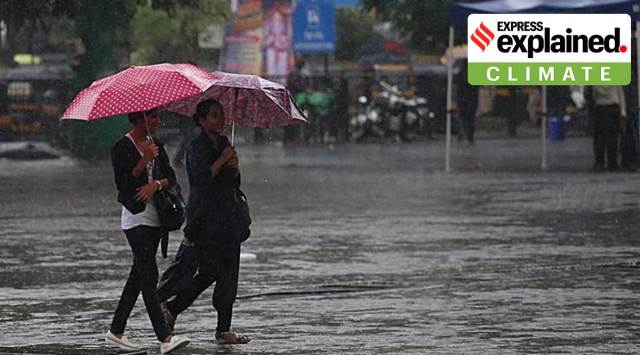Explained: What does a downgrade in average monsoon rainfall mean?
A look at how rainfall is distributed across the country through the year, and what the downgrade means.

In its first-stage long range forecast for the 2022 southwest monsoon, the India Meteorological Department (IMD) has forecast normal rainfall during the season. It has, however, downgraded the Long Period Average (LPA) for all-India monsoon rainfall — from 88.06 cm cm to 87 cm, effective from June this year. A look at how rainfall is distributed across the country through the year, and what the downgrade means:
How much rainfall does India receive on average in a year?
Based on trends for 1961-2010, India’s normal annual rainfall is about 1176.9mm. Of this, nearly 74.8%, or 880.6 mm (88.06 cm), occurs during the Southwest monsoon from June to September. This is the LPA rainfall for the monsoon, the figure that has been revised.
Before the revision, the distribution of the rest of the rainfall was 3.4% during winter (January-February); 11.2% in the pre-monsoon season (March-May), and 10.5% during the post-monsoon season (October-December).
 Source: IMD
Source: IMD
When is the LPA revised?
It is an international convention to verify the quantum of annual and seasonal monsoon rainfall once in a decade. The monsoon season’s LPA rainfall acts as a baseline figure calculated over a 50-year period. The LPA is revised, if required, depending on any variations observed from the rainfall data obtained from the network of rain gauges.
In 2002, the IMD operated 1,963 rain gauges located across 523 districts. As of 2020, rainfall data was being collected from 4,132 rain gauges spread uniformly across 703 districts.
Between 2005 and 2010, India’s LPA was taken at 89.04 cm. Between 2011 and 2015, the IMD revised it to 88.75 cm. It was 88.06 cm between 2018 and 2021. From the upcoming monsoon the revised LPA will be 87 cm.
Why has it been downgraded?
“The monsoon season rainfall shows an epochal behaviour, wherein the monsoon can shift between dry and wet epochs (30-to-50-year periods) in certain decades. The reduction in the rainfall is thus due to the natural multi-decadal rainfall variability,” said Mrutyunjay Mohapatra, director general, IMD.
The decadal variability between 1901 and 2020 shows the southwest monsoon rainfall underwent a dry epoch between 1901 and 1921. This was followed by a wet epoch that prevailed till 1970. From 1971, the monsoon has been passing through a dry epoch that persists till date.
“The dry epoch started in 1971 and has continued for five decades; thus the decadal mean rainfall values have remained negative. The decadal all-India southwest monsoon rainfall has been thus reducing by 1 cm. For 2011-2020, this value is minus 3.8, below normal,” said Pulak Guhathakurta, head, Climate Research Division at IMD, Pune.
But the peak of this dry epoch has been surpassed with the monsoon set to revive, Mohapatra said. “The future trend suggests that the decadal mean value will reach near normal during 2021-2030. It will then turn positive, meaning that the decade 2031-2040 will be the beginning of a wet epoch,” he said.
The decadal mean value for the ongoing decade is predicted to be around minus 1.4 to 1.5.
Normally, the realised monsoon rainfall remains below normal for most years in a decade during a dry epoch. On the other hand, rainfall is normal or above normal during most of the years in a decade when it is a wet epoch.
So, has the all-India quantitative rainfall reduced?
There is indeed a decrease in normal monsoon rainfall between 1961-2010 (880.6 mm) and 1971-2020 (868.6 mm). The all-India annual rainfall, too, has decreased from 1176.9 mm (based on 1961-2010) to 1160.1mm (based on 1971-2020).
“But spatially or seasonally, the rainfall distribution has not undergone significant change, except some decrease during the southwest monsoon season,” said Mohapatra.
Rainfall variations are natural over a country as large as India, and often non-uniform. Across the country, the number of dry spells and extreme rain events during short time-spans have been on the rise, Met officials said.
 Rainfall over the Northeastern region has been on the decline since the 1950s, particularly in the past three decades. “Normal rainfall over Arunachal Pradesh, Nagaland, Manipur, Mizoram and Tripura recorded during 1971-2020 was less than during 1961-2010,” Mohapatra said.
Rainfall over the Northeastern region has been on the decline since the 1950s, particularly in the past three decades. “Normal rainfall over Arunachal Pradesh, Nagaland, Manipur, Mizoram and Tripura recorded during 1971-2020 was less than during 1961-2010,” Mohapatra said.
Guhathakurta said: “On regional scales, the shifting of rainfall patterns and reduction in rainfall is due to climate change which is observed over Northeast India.”
With the shifting of rainfall, the otherwise dry and arid west-central India regions covering Kutch-Saurashtra, Rajasthan and parts of west Madhya Pradesh are reporting a higher number of wet days than normal. These areas had more rainfall during 1971-2020 than during 1961-2010, the IMD chief said.
“There is a positive change in western India regions with research showing an increase in days with light to moderate intensity rainfall increasing over Rajasthan,” he said.
However, on an all-India basis, rainfall reduction in some areas and increase in other areas do not contribute in a large difference in the total quantum.
Newsletter | Click to get the day’s best explainers in your inbox
- 01
- 02
- 03
- 04
- 05






































